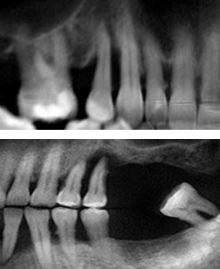HEALTH RISKS GO FAR BEYOND LOSING TEETH
Contrary to what you may tell your kids, gum disease is NOT the result of filling your mouth with too much bubble gum. Also called periodontal disease, gum disease is a serious condition that’s the main cause for tooth loss after age 35. What you may not know about gum disease is it also increases your risk for stroke, diabetes, heart disease and premature low-birth weight babies.
 “Hold on,” you may be thinking. “How does a problem with my teeth result in a stroke or heart disease?” Excellent question. The answer is a bit complex but very important to understand.
“Hold on,” you may be thinking. “How does a problem with my teeth result in a stroke or heart disease?” Excellent question. The answer is a bit complex but very important to understand.
Gum disease starts out as a gingival inflammation (called gingivitis) that is caused by bacterial plaque. If the inflammation is allowed to continue long term, it can destroy the top layers of connective tissue and bone that attach the gingiva to the teeth. When this happens, the sulcus depth or pocket around the teeth becomes progressively deeper and more anaerobic (less exposed to oxygen). The more anaerobic, the more toxic the bacteria become down in the pockets. The toxins diffuse into the surrounding tissues and bone and eventually make their way into the lymph system and then the blood stream.
These toxins are believed to cause inflammation in the wall of blood vessels. This inflammation doubles a person’s risk for myocardial infarction and increases the risk of strokes and diabetes. Consider that the association between heart disease and these anaerobic toxins is greater than the association between heart disease and smoking. That fact alone ought to make you want to get your teeth cleaned regularly!
Contrary to what you may tell your kids, gum disease is NOT the result of filling your mouth with too much bubble gum. Also called periodontal disease, gum disease is a serious condition that’s the main cause for tooth loss after age 35. What you may not know about gum disease is it also increases your risk for stroke, diabetes, heart disease and premature low-birth weight babies.
“Hold on,” you may be thinking. “How does a problem with my teeth result in a stroke or heart disease?” Excellent question. The answer is a bit complex but very important to understand.

Gum disease starts out as a gingival inflammation (called gingivitis) that is caused by bacterial plaque. If the inflammation is allowed to continue long term, it can destroy the top layers of connective tissue and bone that attach the gingiva to the teeth. When this happens, the sulcus depth or pocket around the teeth becomes progressively deeper and more anaerobic (less exposed to oxygen). The more anaerobic, the more toxic the bacteria become down in the pockets. The toxins diffuse into the surrounding tissues and bone and eventually make their way into the lymph system and then the blood stream.
These toxins are believed to cause inflammation in the wall of blood vessels. This inflammation doubles a person’s risk for myocardial infarction and increases the risk of strokes and diabetes. Consider that the association between heart disease and these anaerobic toxins is greater than the association between heart disease and smoking. That fact alone ought to make you want to get your teeth cleaned regularly!
Risk Factors
The main risk factor for gum disease is obviously not keeping your teeth clean. Studies show that cleaning our teeth thoroughly once per day will help prevent gingivitis. The emphasis here is on “thoroughly.” On average, a professional cleaning by a dental hygienist every six months is mandatory. However, some of my patients require a three-month recall visit if they have had active periodontal disease.
Another risk factor is having mercury amalgam fillings in your teeth. Autopsy studies have shown that the periodontal tissues adjacent to teeth with mercury fillings are much higher in mercury concentration. We know these concentrations reduce the healing ability of the gum tissue and causes oxidative stress (free radical) damage.
Another risk factor that is not well known is using fluoridated toothpaste or mouth rinse. Research shows that fluoride activates G proteins in the oral cavity, which causes inflammation that leads to periodontal disease. Fluoride is more toxic than lead and has no place in the human body. Fluoride is not an essential trace element or a nutrient and has no value in reducing decay systemically. It has limited value in reducing decay topically but the risks outweigh the questionable benefits. I recommend a non-fluoridated toothpaste with essential oils and xylitol like Dentarome® from Young Living.
These aren’t the only risk factors, but they are the major players. Other risk factors for gum disease include smoking and poor nutrition, so like all medical professionals I encourage my patients to stop smoking (or don’t start) and to eat a healthy diet. I may also recommend specific supplements if I determine, based on patient history and an examination, that those may be beneficial.
Treatment Options
There are many stages and severities of periodontal disease. The beginning gingivitis stage can be easily treated with a dental cleaning and learning how to keep the teeth clean daily. Most people can learn how to properly use a manual toothbrush and floss, but for some an electric toothbrush like a Rotadent® or Sonicare® help them do a better job. Oral irrigators, especially the Hydrofloss® brand, work very well but do make some noise and can be messy.
When sulcus depths reach between 3-5 millimeters, combined with a great deal of tarter or calculus (mineralized plaque) buildup on their teeth, the dentist may recommend quadrant scaling under local anesthesia. Many times pocket depths in this range, if accompanied by red inflamed gingiva, will shrink down to a healthy 1-3 millimeters and the gingiva will regain its pink healthy color after the teeth are cleaned.
Pockets depths of 6 millimeters or more usually require surgery. The latest, easiest and most effective surgery is called Laser Assisted New Attachment Procedure, LANAP® for short. The patented procedure uses a special infrared laser and has been proven to grow back new bone, connective tissue and cementum. It’s a bit like turning the clock back 10 or 20 years. It does not require any cutting or suturing and most patients do not require pain meds after the procedure.
Modern technology is nice but it’s better and cheaper to prevent gum disease from the start. I suggest following your dentist’s recommendation for recall visits and doing a thorough job of cleaning your teeth at least once per day.

